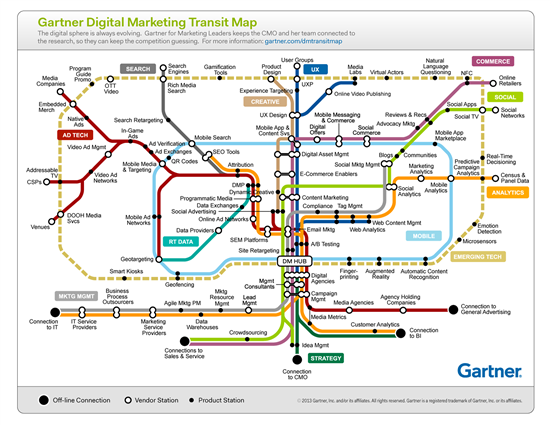I’m pretty sure no CIO or chief marketing officer (CMO) would argue this fact: As digital technology has evolved, the worlds of IT and marketing have become even more complicated and intertwined. What were once separate functions in organizations, particularly large ones, have increased in complexity. Silos are falling, digital technology is no longer the sole bastion of the IT department, and agile, cross-functioning teams are becoming the norm. Today, no CIO or CMO can possibly know it all.
The reality is we are operating in a time when it is rare that one “expert” can possess the skills required to deliver the desired digital outcomes single-handedly. The crossover between IT departments and sales and marketing have become too complex and sophisticated, and there are too many moving parts for an individual to really have deep, across-the-board expertise. As many IT pros would attest, just keeping up with the rapid pace of technological development is a full-time job.
Take a look at Gartner’s Digital Marketing Transit Map, and you will get an idea of how complex and interdependent the digital marketing and technology landscapes have become. If it doesn’t make your head spin just a little, I’d be surprised.
The team members behind this Digital Marketing Transit Map wanted to illustrate the connection between the various business functions (the neighborhoods), applications (tracks) and providers (stations) to facilitate discussion between CIOs and CMOs. They have certainly succeeded in laying out how complex the two disciplines have become, and we find this a great visual aid when talking with (or arm wrestling with) senior leadership about budget allocations. There’s one thing for sure that even a cursory glance will show: As mentioned above, it’s virtually impossible for anyone to look at this map and claim to be an expert in every part of it.
Why full stack?
Is this complexity of today’s business landscape a bad thing? I don’t believe so. I think this increased complexity gives organizations the opportunity to embrace the concept of the “full stack.” And this is what CIOs and CMOs need to focus on to #BeFutureReady. The concept of full stack is familiar to anyone in IT, but likely isn’t for an average CMO. Traditionally, the full-stack developer was one that simplified the process of developing and managing a business website (or other project) by providing all of the expertise that previously required an expensive team of specialists.
“Increasing complexity in both IT and marketing has been expanding the size and scope of the 'stack' … and that’s where the adoption of a full-stack mentality and processes will play a key role.”
Increasing complexity in both IT and marketing has been expanding the size and scope of the “stack” that we’re collectively trying to get our arms around, and that’s where the adoption of a full-stack mentality and processes will play a key role. Not in the traditional sense, with a single individual to cover all the bases, but with the development of “full-stack integrators” who tie the separate tiers within the organization together to produce efficient and cost-effective outcomes.
Practicing full-stack integration
In TechCrunch last year, Sapho founder and CTO Peter Yared suggested that the era of the full-stack developer was coming to an end and that the full-stack “integrator” is now coming to the fore. The more complicated processes and technologies that are all part of the day-to-day realities of an IT team require us once again to have specialists at every level and/or to partner with MSPs to help deliver services we don’t have on-staff expertise to handle. It is becoming vital to business operations to have people who understand how the architecture of the stack works and how to connect those experts to produce the desired outcome — hence, the need for “full-stack integrators.”
Add in the marketing angle and, as the graphic illustrates, you have additional layers of complexity. All of the technological challenges remain, and you can now add analytics, multichannel attribution, SEO, marketing automation, content marketing, social media and myriad other aspects of today’s sophisticated digital marketing. More people and more processes make for greater communication challenges and the potential for increased costs and loss of focus on the intended outcome. Successfully integrating these diverse elements of a business is therefore crucial to its future success.
Today, the key to success is building agile, cross-functioning teams in both IT and marketing, comprising people who individually have the expertise and knowledge you collectively need, and who also have the skills to connect the dots, work collaboratively and integrate effectively across the organization.
It’s more important than ever not to silo teams. So while understanding the premise of full stack is important, actually practicing the concept of “full-stack integration” for your technology teams and their marketing counterparts will be what it takes to make an organization really future ready.
Do you see a convergence of marketing and IT in your work and a new breed of integrator emerging to tie the resulting stack together? I’d love to hear the challenges you’re facing within your organization and how you’re handling them.
Other resources on this topic
http://blogs.gartner.com/jake-sorofman/the-age-of-the-full-stack-marketer/
https://medium.com/@chrismessina/the-full-stack-employee-ed0db089f0a1
This post was written as part of the Dell Insight Partners program, which provides news and analysis about the evolving world of tech. Dell sponsored this article, but the opinions are my own and don’t necessarily represent Dell’s positions or strategies.
